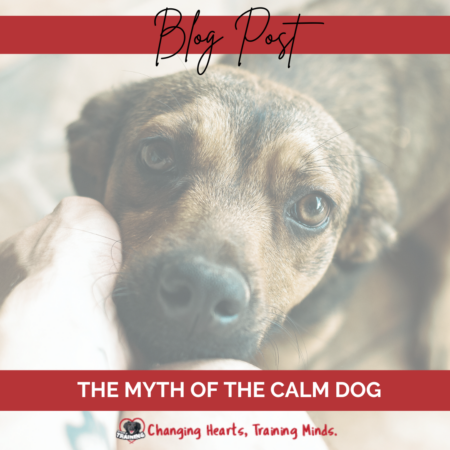TV trainers have done a lot of damage over the last couple of decades, and one of those things is pushing the idea that a “calm” dog is the ideal state we want to achieve for our dogs all the time. I like calm dogs when they’re seniors and like to snooze. Or if a dog is tired from exercise, play, enrichment and training. But just having a “calm” dog, to me, all the time, especially if that dog is a young, healthy, active, energetic dog, is a red flag.
Calm to me often indicates fear or illness. Healthy, young dogs are supposed to be active, curious, a little mischievous and keep us on our toes. Dogs that have been trained with aversives are often “calm” because they’re terrified to make a mistake and be shocked or otherwise hurt or scared. They live in a state of terror, afraid an eyebrow twitch might cause them to feel pain suddenly. Or they’re shut down from learned helplessness, having learned there’s nothing they can do to avoid the scary stuff from happening.
Don’t misunderstand. I’m not advocating for a free for all with rude, inappropriate behaviors. By all means, we train manners and basic skills like no jumping on people so our dogs can fit politely into our lives. But I don’t want any dog to be “calm” because they’re afraid of physical repercussions if they make a mistake. I would much rather a happy go lucky social dog who is excited when people come over and has a hard time keeping it together because he wants to greet than a “calm” dog scared to move or make a mistake, lest he get a shock in his neck.
Another concern about “calm” dogs is in the arena of separation anxiety. Yes, when working with dogs who are afraid to be alone, we absolutely want them to learn to be comfortable and relaxed when they’re alone but this protocol doesn’t involve a “relaxation protocol” or any version of a down/stay on a mat during absences. This is a great way to ruin your actual down/stay since when you get into longer absences (like hours) nobody will be around to reward the dog if they actually hold that stay. But on a more ethical level, it’s pretty unrealistic and unethical, in my opinion, to expect any living being to hold a position for hours and not move a muscle, not get up for a drink, not readjust or move around. And, from a training perspective, we know that teaching a down/stay isn’t how we teach dogs to overcome separation anxiety. Shadowing isn’t a prognostic indicator of separation anxiety and reducing it isn’t how we fix sep anx. Separation anxiety training success is achieved through a personalized, proven systematic training protocol, which means your dog learns how to be safe during absences by breaking those absences up into tiny, manageable pieces your dog can handle. Want more information on separation anxiety and common suggestions that won’t help? Download my free guide here.
So I encourage you to train skills that are useful for day to day manners and inclusion but not to strive for a state of perpetual calm. And to seek out qualified trainers to help guide you. Contact me if you need help or a referral.
Happy training!
![]()




